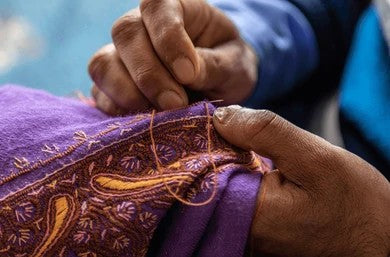
Is Your Pashmina Authentic?
Share
Home / kAARKASH Blog /
Authentic Pashmina or Fake? A Simple Guide to Spot the Difference
Febuaruy 08 - 2025 . Kaarkash
Introduction
Pashmina—the "diamond fiber"—has been a mark of luxury for centuries. Soft, warm, and effortlessly elegant, this exquisite fabric originates from the high-altitude Himalayas. But with rising demand comes a flood of counterfeits. So, how can you be sure your pashmina is the real deal? Let’s break it down.

What Exactly Is Pashmina?
Pashmina is made from the ultra-fine undercoat of the Changthangi goat, a breed that thrives in the freezing Himalayas. These goats grow a thick fleece to survive harsh winters, which is carefully hand-combed in the spring. Unlike regular cashmere, pashmina fibers are incredibly fine (12-16 microns) and are traditionally handwoven by skilled artisans in Kashmir.

Why Authenticity Matters
Quality That Lasts: Genuine pashmina is lightweight, breathable, and gets even softer over time.
Ethical Craftsmanship: Buying real pashmina supports skilled artisans and keeps centuries-old weaving traditions alive.
Eco-Friendly: Unlike synthetic alternatives, natural pashmina is biodegradable and doesn’t contribute to microplastic pollution.

How to Spot a Genuine Pashmina: 5 Simple Tests
1. The Touch Test
- Real: Feels buttery soft, slightly fuzzy, and warm against your skin.
- Fake: May feel too slick, stiff, or unnaturally smooth.
2. The Burn Test (Handle With Care!)
Snip a tiny fiber and burn it.
- Real: Smells like burnt hair and crumbles to ash.
- Fake: Smells like plastic and melts into hard beads.
3. The Weave Inspection
- Real: Handwoven pieces have slight irregularities, and fibers may vary in thickness.
- Fake: Machine-made fabrics are too perfect—tight, flawless, and uniform.
4. The Price Check
If a "pashmina" scarf costs less than $200, it’s probably a blend or synthetic. True pashmina is labor-intensive, and its price reflects that craftsmanship.
5. The Water Test
Sprinkle a little water on the fabric.
- Real: Absorbs moisture quickly.
- Fake: Water beads up or rolls off.

Red Flags to Watch Out For
🚫 Machine Washable Labels: Real pashmina requires delicate care—hand washing or dry cleaning only.
🚫 Too Perfect to Be True: Uniform colors and flawless texture often signal synthetic fibers.
🚫 No Mention of Origin: Authentic pashmina sellers are transparent about sourcing. Look for certifications like the Pashmina Certification Mark from Kashmir.
Caring for Your Pashmina
✔ Hand wash in cold water with mild detergent.
✔ Lay flat to dry (never wring it out).
✔ Store properly—fold it in breathable fabric to protect it from moths.
Conclusion
A genuine pashmina is more than just a scarf—it’s an investment in tradition, craftsmanship, and sustainability. By learning to recognize the real thing, you’re not only getting a timeless luxury piece but also supporting the artisans who keep this heritage alive. So, the next time you wrap yourself in a pashmina, let it be one that tells a story of authenticity and artistry.
